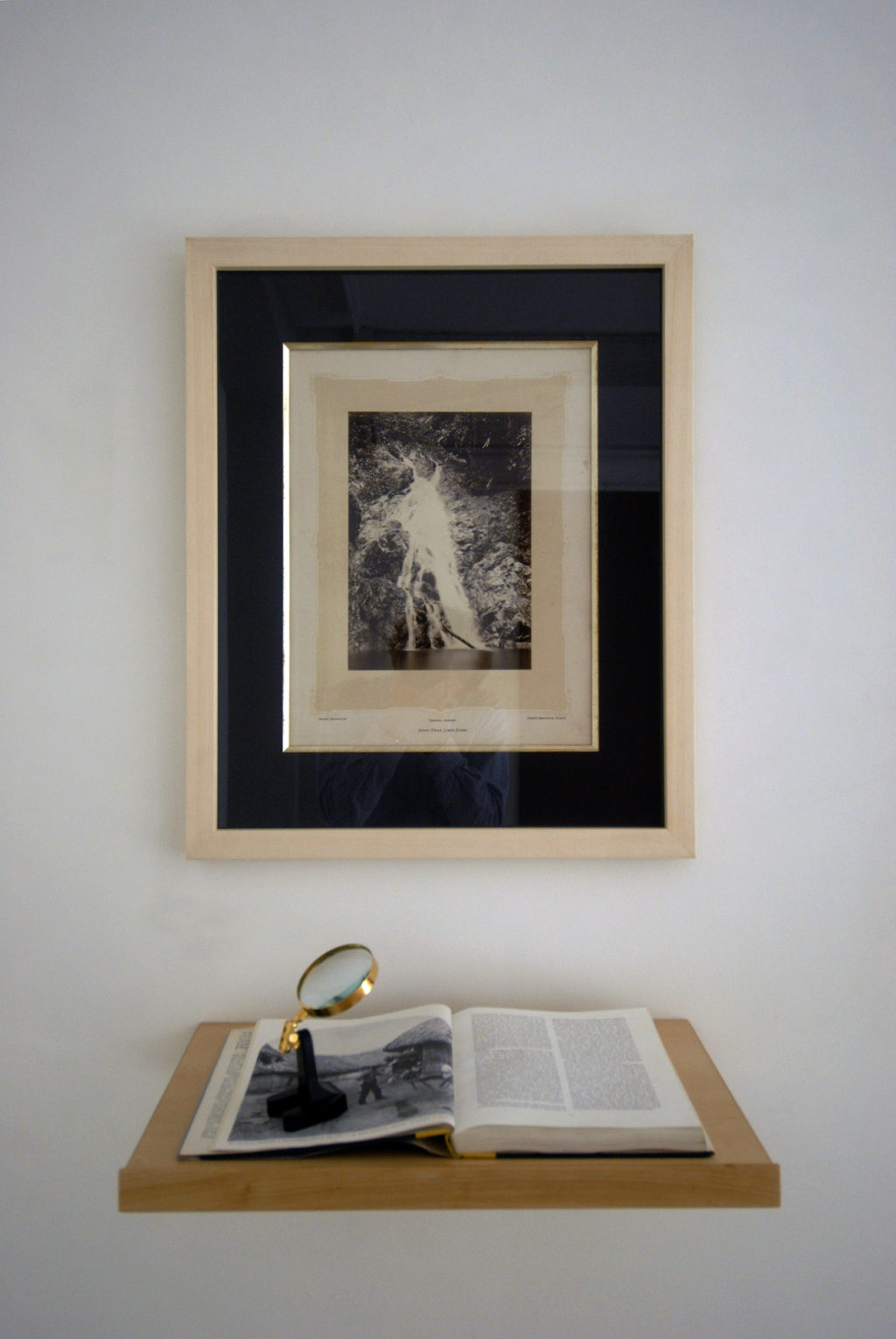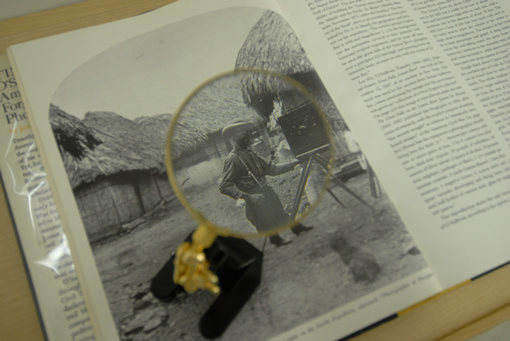
First Seen, 2008
detail
vintage photograph 28,0 x 20,3 cm, attributed to John Moran (1829-1902) and titled ‘Tropical Scenery, Great Falls, Limon River’, 1871
First Seen, 2008
First Seen, 2008
Vintage print Great Falls Limon River, attr. John Moran made during the Darien-expedition, 1871, shelf, biography on Timothy O’Sullivan with new page with text by Matts Leiderstam binded in, magnifying glass (text with similar fond and on similar paper as pages in original biography on Timothy O’Sullivan).
The text you will find here too:
Under the leadership of Commander Thomas Oliver Selfridge of the United States Navy, the Darien Expedition was sent out on its second journey, 1870-71, to search for an “old Indian trail” across the mountains through the jungle, from “Cupica Bay by way of the Limon River, the Napipi River to the Atrato River, falling into the Gulf of Darien” (Golfo de Uraba). The aim was to investigate the possibility of building the “Darien ship-canal” between the Atlantic and the Pacific. In Harper’s Monthly Magazine, November 1873, under the heading “The Secret of the Strait”, there is an eyewitness account published by Dr. G. A. Maack, the geographer and botanist on the expedition. “The scenery around Cupica Bay is wild and magnificent. Large boulders of every size and shape lie scattered in wild confusion, all thickly crusted with shells and sea animals. The waves, dashing through ages, have undermined the rocky wall in many places, forming caves and fantastic grottoes, where the sea foams and boils as if eager to carry its work of destruction still further. In the background rise the mountains, covered to their summits with luxuriant tropical vegetation, and far away off may be seen the great falls of the Limon River plunging over a precipice 250 feet high, and pouring down an immense body of water to mix with the ocean at Limon Bay.”
Lot 302, “O’Sullivan, Timothy (1840–1882), Tropical Scenery, Great Falls, Limon River” was sold on December 13, 2007, at an auction in New York. The book, Timothy O’Sullivan, America’s Forgotten Photographer, was used by the auction firm, Swann Galleries Inc., when attributing the image as an O’Sullivan and the provenance was given as “collection of a New England collector”. On page 233 in the book this image is reproduced under the title The Great Falls on the Limón River. James D. Horan (1914–1981), American novelist, journalist and historian, published this biography of O’Sullivan in 1966, after years of research, with the explicit purpose of setting “the record straight” in relation to “mistakenly attributed images” of the American Civil War. On page five Horan lists the equipment a photographer should bring into the field during this period: a “… stereoscopic camera with one or more pairs of lens; 5 by 8 camera box plus lens; dark tent; tripods; 10 pounds of collodion; 36 ounces of silver nitrate; 2 quarts of alcohol; 10 pounds iron sulphate; packages of filters; 1 ¼ pounds potassium cyanide; 3 yards Canton flannel; 1 box Rottenstone; 3 negative boxes; 6 ounces nitric aid; 1 quart varnish; developing and fixing trays; dozen and half bottles of various sizes; glass for negatives, 400 pieces.”
The reproduction shows “the only known photograph of Tim O’Sullivan”, according to the caption, is part of a stereoscopic picture. According to George Eastman House, Rochester, NY, this image was ascribed to another photographer in 1976, based on Commander Selfridge’s report from the Darien Expedition, as a self-portrait of John Moran (1831–1902). On Eastman House’s web pages, 54 Darien Expedition stereoscopic pictures from their collection are reproduced, eight of which are attributed to O’Sullivan and the expedition’s first journey in 1870, and the rest to Moran on the second journey in 1870–1871. The picture representing Moran was shot in the village of Pinogana, Panama, at the Rio Tuyra in the spring of 1871, a few weeks before, or after, the expedition reached “the great falls of the Limon River”.
Commander Selfridge writes in his report: “Monday morning [March 13 1871] we got under way and proceeded to the mouth of Limon River, where the trail to the Napipi begins, … […] The Limon River for about 3,000 feet from the sea to the falls has a width in its bed of about 250 feet, and lies between high hills on each side, with a moderate rise in the distance of about 70 feet. The falls have a leap of 250 feet over hard rock, and in the rainy season, when the volume of the water is large, must be magnificent. The scenery in the vicinity is both picturesque and grand. A deep basin receives the cool falling water, the spray from which forms tiny rainbows in the noonday sun; moss-covered rocks surround it; while above tower high hills festooned with dense masses of vines.”
Google Earth’s satellite image shows Cupica and Bahía Limón in the northern part of Golfo de Cupica. Bahía Solano can be found close by with a few eco-tourist beach hotels. The whole coastline along the Pacific is covered by virgin rainforest, which is practically isolated from the rest of the country and has an annual rainfall of up to 10 metres – three times more than in the Amazon Rainforest. On one of the hotel’s web pages, waterfalls with names such as Nabugá and Chirichiri are presented as possible goals for excursion. On January 14, 2008, CNN reported from Bogotá: “The same leftist rebel group that released two long-held hostages three days ago has kidnapped six tourists at a remote beach on Colombia’s Pacific coast, a spokeswoman for the Colombian navy said Monday. The kidnapping by the Revolutionary Armed Forces of Colombia, or FARC, the Spanish acronym by which the group is known, took place at dusk Sunday when a motorboat with the tourists went ashore … The boat had set sail with 19 passengers from Bahia Solano, a port farther north, the spokeswoman said. Rebels stole fuel from the boat along with the passengers’ cash and cell phones, a navy statement said. It said rebels then selected six of the passengers and led them into the nearby jungle.”

First Seen, 2008
photograph 28,0 x 20,3 cm in frame 67 x 55 x 3 cm
Shelf: 35,5 x 53 x 6,5 cm
1 book with new text, magnifying glass
Vintage albumenprint attributed to John Moran (1829-1902), ‘Tropical Scenery, Great Falls, Limon River’, 1871, framed
private collection Rotterdam


First Seen, 2008
detail of vintage photograph 28,0 x 20,3 cm, attributed to John Moran (1829-1902) and titled ‘Tropical Scenery, Great Falls, Limon River’, 1871, framed
private collection Rotterdam

